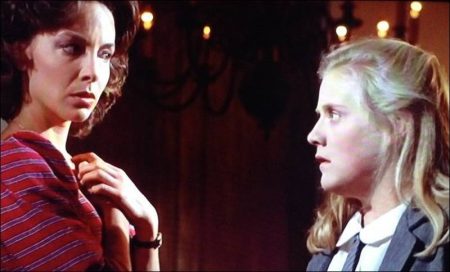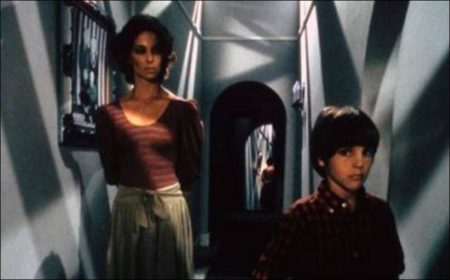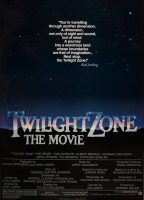Taglines: Next stop, the Twilight Zone!
Twilight Zone: The Movie storyline. Four horror / science-fiction segments directed by four of Hollywood’s famous directors based on TV’s most popular anthology series, bookended by a funny and scary prologue and epilogue. In the first story (a vague remake of the Twilight Zone episode “A Quality of Mercy”), a loud-mouthed bigoted businessman with an intense hatred for Jews, blacks, and Asians, gets the tables turned on him when he walks out a bar and is inexplicably transported back in time to being pursued by Nazis in 1940’s France.
Then as an African-American at a KKK rally in the 1950s Deep South, and as a Vietnamese in 1960s Vietnam. In the second story (a remake of “Kick the Can”), an old man arrives at a retirement home and makes the wishes of the residents come true when he magically transforms them into youthful incarnations of their days gone by.
In the third story (a remake of “It’s a Good Life”), a young woman on the road gives a ride to a mysterious 10-year-old boy to his house and ends up trapped with other people in an alternate reality created by the boy’s imagination. The fourth story (a remake of “Nightmare at 20,000 Feet”) features a passenger on an airline who sees, but cannot convince anyone of, a mysterious creature on the wing of the airplane trying to sabotage the aircraft.
Twilight Zone: The Movie is a 1983 American science fiction horror anthology film produced by Steven Spielberg and John Landis as a cinematic interpretation of the 1959–1964 TV series created by Rod Serling. The film stars Vic Morrow, Scatman Crothers, Kathleen Quinlan, and John Lithgow, with Dan Aykroyd and Albert Brooks in the prologue segment. Burgess Meredith starred in four episodes of the original series and took on Serling’s position as narrator. Other actors from the original series included William Schallert, Kevin McCarthy, Bill Mumy, Murray Matheson, Peter Brocco, and Patricia Barry.
The film is a remake of three episodes of the original series and introduces one original story. Landis directed the prologue, the first segment, and the epilogue; Spielberg directed the second segment, Joe Dante the third, and George Miller the final. Dante recalled that the four stories were originally intended to be interwoven, with characters from one segment appearing in another segment, but problems with the filming precluded this.
The film gained notoriety before its release for the stunt helicopter crash which took the lives of actor Vic Morrow and child actors Myca Dinh Le and Renee Shin-Yi Chen during the filming of the segment directed by Landis. The two child actors had been hired illegally. Their deaths led to a high-profile legal case, although no one was found to be criminally liable for the accident.
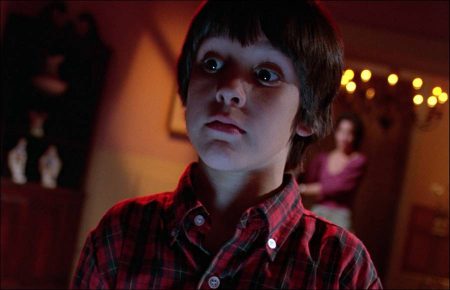
Segments and Storylines
Prologue
The film starts with two men in a car, a driver (Albert Brooks) and his passenger (Dan Aykroyd), driving on a rural two-lane road very late at night, singing along to Creedence Clearwater Revival’s cover of “Midnight Special” on a cassette, which then breaks. (Note: they never address each other by name and it is thus never explained if the two men are best friends, or having just met, or if the passenger is a hitchhiker or so on).
The pair make a game between themselves about TV theme songs, then the conversation turns to what scares them. They begin to talk about their favorite episodes of The Twilight Zone and how weird and scary some of the episodes were. Out of the blue, the passenger then asks the driver, “Do you want to see something really scary?” The driver reluctantly pulls the car over. His friend turns his head away for a few seconds, then turns around, having pulled off a false mask off his face… becoming a demonic creature. The creature then fatally attacks the driver.
The opening scene then cuts to outside the car as the familiar Twilight Zone opening theme music and monologue begin, spoken by narrator Burgess Meredith, a veteran of the original TV series.
“You unlock this door with the key of imagination. Beyond it is another dimension. A dimension of sound. A dimension of sight. A dimension of mind. You’re moving into a land of both shadow and substance of things and ideas. You’ve just crossed over into… The Twilight Zone.”
First Segment (“Time Out”)
“You’re about to meet an angry man: Mr. William Connor, who carries on his shoulder a chip the size of the national debt. This is a sour man, a lonely man, who’s tired of waiting for the breaks that come to others, but never to him. Mr. William Connor, whose own blind hatred is about to catapult him into the darkest corner of the Twilight Zone.”
The only original segment, directed by John Landis. It is loosely based on two original Twilight Zone episodes: “A Quality of Mercy” and “Deaths-Head Revisited”. Bill Conner (Vic Morrow) is an outspoken bigot who is bitter after being passed over for a promotion. Drinking in a bar after work with his friends, Bill makes prejudiced remarks and racial slurs towards Jews, blacks and Asians, attracting the attention of a group of black men sitting near them who, of course, strongly resent his racist comments. Bill leaves the bar very angry.
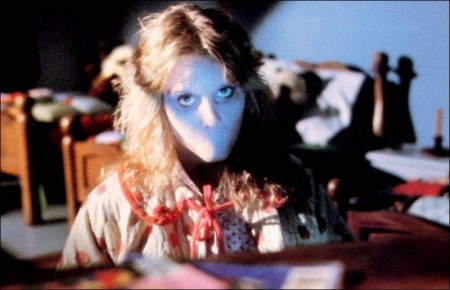
When he walks outside, the supernatural element of this story really begins. Bill finds that he is not in the parking lot. Instead, Bill inexplicably finds himself in Vichy France during World War II. He is spotted by a pair of SS officers patrolling the streets, who see him as a Jewish man. After a chase around the city, in which Bill is shot in his left arm by one of the German officers, Bill attempts to hide in an apartment, but the French woman quickly betrays him by shouting a warning to the German soldiers patrolling the streets. Bill climbs out on a ledge of the building, in trying to escape and finds himself trapped. While the two German officers take pot shots at him standing along the narrow ledge, Bill slips falls off the ledge and suddenly lands on soft earth ground.
Bill discovers that he has time traveled to the rural South during the 1950s, where the Ku Klux Klan sees him as an African American whom they are about to lynch. Bill is scared and confused and vehemently tries to tell them he’s white. After kicking one KKK member against the burning cross and setting him on fire, Bill breaks free and tries to escape (while still hampered by his bullet wound). While trying to escape the Ku Klux Klan members, he dives into a nearby pond and time travels into the Vietnam War, where he is a Vietnamese man nearly blown to bits by U.S. soldiers.
(It is clearly implied at this point that by evil or divine intervention, Bill has become the selected nationalities of the people against whom he was always prejudiced.)
The grenade thrown by the soldiers blasts him back to Vichy France, where he is captured by the same two Nazi officers chasing him and put into an enclosed railroad freight car, along with other Jewish Holocaust prisoners, with no possibility of redemption or rescue. Here the segment suddenly ends with the final shot showing Bill futilely screaming for help to his friends from the bar that only he can see as the train pulls away, presumably to a concentration camp or death camp. (Note: Vic Morrow died in a freak accident during filming, so an additional pall hangs over this whole story.)
Second Segment (“Kick the Can”)
“It is sometimes said that where there is no hope, there is no life. Case in point: the residents of Sunnyvale Rest Home, where hope is just a memory. But hope just checked into Sunnyvale, disguised as an elderly optimist, who carries his magic in a shiny tin can.”
The second segment is directed by Steven Spielberg and is a remake of the episode “Kick the Can.” Mr. Bloom (Scatman Crothers) is an old man who has just moved into his new home at Sunnyvale Retirement Home. Upon his arrival, he sits around kindly and smiles as he listens to the other elders reminisce about the joys they experienced in their days as youths. Mr. Bloom implies to them just because they’re old doesn’t mean they cannot enjoy life anymore and that feeling young and active has to do with your attitude not your age. He tells them that later that night, he will wake them and that they can join him in a game of “kick the can”. All agree; however, a grumpy man named Leo Conroy who is fairly skeptical in his outlook on life disagrees, saying that now that they are all old they cannot engage in physical activity and play the games they once did as children.
That night, Mr. Bloom gathers the rest of the optimistic residents outside and plays a game of kick the can. They are all ultimately transformed back into child versions of themselves. Although they are extremely ecstatic to be young again and engage in the activities they once enjoyed so long ago, they also realize that being young again means you not only experience the good aspects of life again but also the bad. They request to be old again, which Mr. Bloom grants to them. Leo Conroy witnesses one resident that still remains young and says that he wants to go with him before the boy runs off. Conroy realizes that he does not have to stop enjoying life because of his old age.
The segment ends with Mr. Bloom leaving Sunnyvale Retirement Home to move into another retirement home in another town (which leaves the audience to presume that he might be a good magical being who repeats the process eternally), and Conroy is outside the Sunnyvale home happily kicking a can around the backyard, for he has learned being young at heart is what really matters.
Third Segment (“It’s a Good Life”)
“Portrait of a woman in transit: Helen Foley, age 27. Occupation: schoolteacher. Up until now, the pattern of her life has been one of unrelenting sameness, waiting for something different to happen. Helen Foley doesn’t know it yet, but her waiting has just ended.”
The third segment is directed by Joe Dante and is a loose remake of the episode “It’s a Good Life”. Helen Foley (Kathleen Quinlan) is a mild-mannered school teacher who is traveling to her new job across the country. While visiting a rural bar/diner for directions from the owner Walter (Dick Miller), she witnesses a young boy (Jeremy Licht) playing a video game and then being accosted by a group of rowdy drunks for “accidentally” turning off the TV they were watching. Soon after, Helen decides to leave. Not paying attention, she backs into the boy with her car in the parking lot, damaging his bike. Helen offers the boy, Anthony, a ride home.
They eventually get to Anthony’s house, which is an immense home in the country. When Helen arrives, she meets some people whom Anthony tells her are his family, his Uncle Walt (Kevin McCarthy) and his sister Ethel (Nancy Cartwright). Also included in the family are Anthony’s parents. Helen notices that the family seems extremely apprehensive, though she dismisses it. Anthony shows Helen around the house, including his sister’s room; Anthony tells Helen that the girl is his “other” sister Sara (Cherie Currie), who got involved in an accident. The camera pans down and the audience view that the girl has no mouth, unbeknownst to Helen.
The family have dinner, which, as Helen realizes, is a meal made up of Anthony’s favorite foods; mainly fast food, including a burger with peanut butter. During dinner, Ethel shouts at Anthony and her plate smashes on the ground, with no explanation. After satisfying her promise of taking Anthony home, Helen attempts to leave; it is at this point that Helen discovers Anthony possesses unexplained supernatural powers that allow him to do practically anything he desires by wishing whatever he wants, including making cartoon characters appear in real life and making people disappear.
Helen asks to leave, but Anthony insists that she see Uncle Walt’s “act”. Uncle Walt is unsure as to what to do with the top hat that Anthony provides, and reluctantly pulls a white rabbit out of the hat. The family are relieved and applaud, only to see the rabbit become a demonic rabbit-monster before disappearing again. The people finally inform her they aren’t his real family and that they were brought to the house under false pretense by Anthony, as she was. They also explain that they cannot leave for Anthony has imprisoned them there in his own fantasy world that he created out of his mind. Helen finds a note on the floor that a family member has left, reading, “Help us! Anthony is a Monster!”. The note is shown to be from Ethel after a short investigation, and Anthony, using his mental powers, sends Ethel into the television set where she is killed by a large, frightening, somewhat dragon-like cartoon character.
After the “family” has angered Anthony, he instantly makes them and the house disappear, leaving himself and Helen in a limbo-like state surrounded by literal nothingness. Helen promises Anthony that she will be his true friend if he agrees not to abuse his power anymore. Anthony agrees to use his powers for good. He produces Helen’s car and he and Helen ride off together to her new home, surrounded by bright meadows filled with flowers.
Fourth Segment (“Nightmare at 20,000 Feet”)
“What you’re looking at could be the end of a particularly terrifying nightmare. It isn’t. It’s the beginning. Introducing Mr. John Valentine, air traveler. His destination: the Twilight Zone.”
The fourth segment is directed by George Miller and is a remake of the episode “Nightmare at 20,000 Feet”. John Valentine (John Lithgow) is a nervous and stressed-out airline passenger on a flight to Los Angeles. The story begins with flight attendants attempting to coax Mr. Valentine from the lavatory as he tries to recover from what seems to be a panic attack. Although not mentioned during the segment, it is most likely that Mr. Valentine is suffering from severe aviatophobia. He is repeatedly assured by the flight attendants that everything is going to be all right, but his nerves and antics disturb the surrounding passengers.
As Mr. Valentine takes his seat, he notices a hideous gremlin-like creature on the wing of the plane and begins to spiral into severe panic. He watches as the creature wreaks havoc on the wing, losing more control each time he sees it do something new. Valentine finally snaps, grabs a hand gun from another passenger, an air marshal, shoots out the window (causing a breach in the pressurized cabin), and begins firing at the creature. This only serves to catch the attention of the gremlin, who rushes up to Valentine and promptly destroys the gun. After a tense moment, in which they notice that the plane is landing, the gremlin grabs Valentine’s face, then simply scolds him by wagging its finger in a “no, no” manner. The creature leaps into the sky and flies away as the airplane begins to make an emergency landing.
As the delirious and incoherent Valentine is wrapped in a straitjacket and carried off in an ambulance, the police, crew, and passengers begin to discuss the incident, writing off Valentine as insane. The aircraft maintenance crew soon arrives however, and everyone gathers to examine the massive amounts of unexplained damage to the plane’s engines.
Epilogue…
Valentine is in an ambulance going to a hospital when the driver (played by Dan Aykroyd, from the opening) starts playing Creedence Clearwater Revival’s “Midnight Special”. The ambulance driver turns around and says, “Heard you had a big scare up there, huh? Wanna see something really scary?” The film then ends as the scene fades out to a starry night sky along with Rod Serling’s opening monologue from the first season of The Twilight Zone.
“There is a fifth dimension, beyond that which is known to man. It is the middle ground between light and shadow, between science and superstition, and it lies between the pit of man’s fears and the summit of his knowledge. This is the dimension of imagination. It is an area which we call the Twilight Zone.”
Twilight Zone: The Movie (1983)
Directed by: John Landis, Steven Spielberg, Joe Dante, George Miller
Starring: Dan Aykroyd, Albert Brooks, Scatman Crothers, John Lithgow, Vic Morrow, Kathleen Quinlan, Debby Porter, Annette Claudier, Steven Williams, Stephen Bishop
Screenplay by: John Landis, George Clayton Johnson, Melissa Mathison, Richard Matheson
Production Design by: Jim Bissell
Cinematography by: Allen Daviau, John Hora, Stevan Larner
Film Editing by: Malcolm Campbell, Tina Hirsch, Michael Kahn, Howard E. Smith
Costume Design by: Deborah Nadoolman, Deborah Lynn Scott
Set Decoration by: Jackie Carr, Barbara Krieger
Art Direction by: Richard Sawyer, James H. Spencer
Music by: Jerry Goldsmith
MPAA Rating: None.
Distributed by: Warner Bros. Pictures
Release Date: June 24, 1983
Visits: 115
